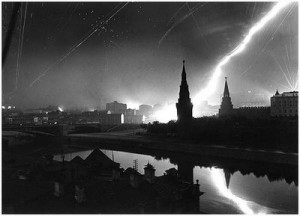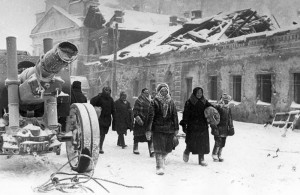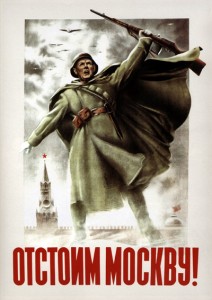Joseph Stalin: “Moscow will be defended to the last!” 70th Anniversary October 19, 1941
“Before three months have passed, we shall witness a collapse in Russia, the like of which has never been seen in history.”—Adolf Hitler, 2:30am, June 22, 1941
October 1941 was an especially grim time for the Soviet Union as it appeared that Adolf Hitler might win his historical gamble to crash in the Soviet Union and end the eastern war with a military victory before the United States was drawn into the conflict. A solitary Great Britain would then be forced to come to terms with Germany’s impregnable continental triumph. Hitler would then be free to pursue his dream of a greater Aryan empire in eastern Europe, an empire economically supported through enslaving the Slavic peoples while cleansing the lands of all racial undesirables. Hitler was betting that a Blitzkreig strike against the Soviet Union could attain a military defeat within six months, paving the way to his Aryan utopia.
The German army which launched Operation Barbarossa at 3:30am on June 22, 1941, along a long front stretching from the Baltic to the Ukraine totaled over 3.1 million men. In its mechanical force it had nineteen panzer divisions and twelve motorized divisions, 3,350 tanks, 5,000 aircraft, and 7,000 pieces of artillery. General von Bock’s Army Group Center, located in the center of the line, had two objectives: first to capture Minsk, and then make the decisive strike to the heart by driving to Moscow. Army Group North would capture the Baltic and Leningrad; Army Group South would drive to Kiev and the southern oil fields. Hitler’s Blitzkreig strategy again relied upon speed, and the initial thrust did not disappoint. His Panzer divisions knifed ahead fifty miles a day once the attack was launched; German forces were overrunning and encircling Soviet troops. Because the Soviet troops had been warned, their superior numbers did not translate into resistance, but rather greater numbers of captured prisoners. The Luftwaffe was initially very effective in cutting rail and road support for the Soviet armies, and over 5,000 Soviet planes were destroyed on the ground by August, almost fifty percent of the Soviet front-line defensive air strength.
Joseph Stalin appears to have been the last political leader to trust the word of Adolf Hitler. The two nations, ideological enemies with competing philosophies of history, both sworn to rule the future of mankind, had become allies with the Nazi-Soviet Pact in August 1939. In reality, it was a gangster tactic, to be discarded when convenient. After the initial onslaught of Hitler’s double-cross, with German troops pouring into the Soviet Union due to his own political miscalculation, the Soviet General Secretary Stalin appears to have suffered some sort of nervous breakdown or collapse. After appearing at the Kremlin on June 23, he retreated to his dacha in Kuntsevo and remained out of communication for the next week. However, the system of government which the dictator had created around him allowed for no initiative without his approval, and his underlings were unable to make the necessary decisions to defend the nation without Stalin’s direction. On June 30, a group of Politburo leaders appeared at Stalin’s dacha; he apparently believed they had come to kill him for his failure, but instead they asked him to come back to the Kremlin. Stalin regained his composure and nerve. He centered all major policy powers within his person—economic, political and military—by making himself the Supreme Commander of the Stavka, or High Command Headquarters.
By October, the situation was hitting its crisis peak. After the battles of Vyazma-Bryansk, the German 4th Panzer division under Guderian took the city of Orel on October 8. It was at this point that the road to Moscow lay open. Despite reports of unfavorable weather ahead, and shortfalls of supplies, the Germans were intent on pressing on to Moscow. After the capture of Orel, the German General Jodl reported to Hitler: “We have finally and without any exaggeration won the war!” Hitler allowed his press secretary, Otto Dietrich, to release a statement: “For all military purposes Soviet Russia is done with.”
There were, however, a few positive signs at this time on the Soviet side which augured for a different destiny. On October 7, the first snows fell, but melted away quickly. And on October 10, Stalin appointed General Georgi Zhukov to take command of the new Soviet western front army designed for the defense of Moscow. But things were still dire– when he assumed command, Zhukov found himself with in charge of an army of 90,000 troops spread over a 150 mile front, reduced down from over 800,000 due to captured prisoners taken by the German advance. Nearly three million Soviet troops had been captured at this point by the German juggernaut.
The Germans were at the gates. On October 14, the German Army group in the center offensive took Kalinin, northwest of Moscow. On October 16, Odessa fell to German and Rumanian troops in the southern sector, while Vaidal in the northern sector also fell to the Germans. October 16th became known as the Bolshoi drap in Moscow, the day of the “Great Panic.” The Soviet government began to evacuate across the Ural mountains to Kuibyshev, over 600 miles away. Party officials jammed the roads and railway stations while offices and factories emptied out; the general public took their cue and joined the exodus. Looting was extensive in the empty streets without any police force to keep order. Pistol shots could be heard during the day, and at night German bombers and incendiaries lit up the skyline. The Soviet military mined bridges and railway connections to the city to prevent the advancing Germans from entry. Chaos reigned in the Soviet capitol, and rumors swiftly flamed terror amongst the populace of what treatment they could expect at the hands of the German army based upon the atrocities and executions the Germans had committed in the advance thus far.
Stalin himself had ordered his special railway car prepared for evacuation on the sixteenth. However, he did not leave the city. He pondered whether or not Hitler might not be willing to come to an agreement similar to the Brest-Litovsk treaty of 1918, in which Russia exchanged huge swaths of territory for peace with Germany and the continued existence of the Communist government. He rejected this remote. He called on Zhukov and implored him to give assurance that Moscow could be held. Gaining Zhukov’s assurance, he then made the decision to stay. He proclaimed a state of siege and placed the city under martial law, with the standing order of the day: “Moscow will be defended to the last!”
Special reinforcements of NKVD troops (the Soviet secret police, which had been placed behind Soviet military lines with orders to shoot all who attempted retreat) were now placed in Moscow’s snow-covered, empty streets to enforce order. Looting and trading on the black market were punished by immediate execution without trial. A half million Muscovite men and women strung over 185 miles of barbed wire, dug over 5,000 miles of trenches, ditches, tank-traps and felled trees in a defensive crescent before the city.
And at this point a new spirit of resolve infused the Soviet peoples. It was full of defiance and despair, of grim determination and stoic contemplation of death, of self-sacrifice and supreme will. The historian Alan Clarke provides a glimpse of this spirit in a letter he quotes from a Soviet citizen of the time:
“Even those of us who knew that our government was wicked, that there was little to choose between the SS and the NKVD except their language, and who despised the hypocrisy of Communist politics—we felt that we must fight. Because every Russian who had lived through the Revolution and the thirties had felt a breeze of hope, for the first time in the history of our people. We were like the bud at the tip of a root which has wound its way for centuries under rocky soil. We felt ourselves to be within inches of the open sky.
“We knew that we would die, of course. But our children would inherit two things: A land free of the invader; and Time, in which the progressive ideals of Communism might emerge.” (Clark, Barbarossa, p. 187)
It should be noted that Joseph Stalin’s regime had been a disaster for the Russian people. In the 1930s Stalin’s regime was responsible for the death by starvation of nearly seven million in the Ukraine, his Great Terror had seen two million executed, virtually all individual freedoms had been stamped out, and the Gulag Archipelago was continuously filled with at least ten million imprisoned Russians throughout his 25 year reign. Yet the Russian people rallied to his call to defend their land against monstrous odds. They stiffened their slender hopes for a better future against a fate of being sub-human slaves to Adolf Hitler.
The Russian winter began to make its presence felt in mid-October as sleet and rain began to fall, soaking the few roads into Moscow; at night the temperatures fell below freezing and iced over the roads, and with the morning thaws created mud-churned bogs, un-passable by trucks and tanks. Damp overcast skies filled with mists and snow flurries prevented peak efficiency by the Luftwaffe. The weather conditions in the last three weeks of October caused the German army to experience a slippery, halting, slowly grinding advance toward the gates of Moscow. Less than fifty miles from Moscow, the German army needed fresh reinforcements of troops, winter clothing and supplies, and a re-grouped strategy. And this change in the weather also began to bring eerie historical echoes to the minds of German military leaders:
“Most of the commanders were now asking: ‘When are we going to stop?’ They remembered what had happened to Napoleon’s army. Most of them began to re-read Caulaincourt’s grim account of 1812. That book had a weighty influence at this critical time in 1941. I can still see Von Kluge trudging through the mud from his sleeping quarters to his office, and standing there before the map with Caulaincourt’s book in his hand. That went on day after day.” (Clark, Barbarossa, p. 190)
The ghosts of a pending historical disaster stalked the scene.
This time allowed Stalin to reinforce his own armies with fresh troops drawn from Siberia (he was now certain that Japan would not attack from the east). Reserves of over eight rifle divisions, 1,700 tanks, and 1,500 aircraft were infused into the reserves around Moscow which Stavka was creating to protect the city. They were not immediately thrown into battle. And as Soviet military strength increased, so did the political will to resist. As the ultimate showdown between Stalin and Hitler increased in tempo, Stalin answered Hitler’s early October victory announcement. Underground in the Mayakovsky metro station on November 6, in front of a packed crowd composed of selected Communist party, Red Army, and Moscow city officials, Stalin answered Hitler’s invasion with a defiant promise: “If they want a war of extermination, they shall have one.” On the twenty-fourth anniversary of the Red Revolution the next day, November 7, Stalin attended the annual military parade in Red Square despite the threat of Luftwaffe attack. He offered the Soviet military his salute.
The final German offensive for Moscow would be launched in mid-November. The Soviets were still a month away from their first military counter-offensive against the German army (that would fall on December 6). They were still faced with a battle for the city that would last through January 1942. They would then face an even greater task in the battle for Stalingrad in 1942-43, before the tide of the German Barbarossa offensive would indeed finally be turned, and the Red Army begin the long offensive advance towards Germany and finally into Hitler’s lair in Berlin. The cost in bloodshed would be enormous. However, the first glimmerings of this future ultimately can be traced back to Stalin’s commitment to hold Moscow in October 1941 when all truly appeared to be lost on the Soviet side.
Dr. Keith Huxen is the Senior Director of Research and History at the National World War II Museum.
- Posted :
- Post Category :
- Tags : Tags: 1941, Eastern Front, Hitler, Keith Huxen, Stalin
- Follow responses to this entry through the RSS 2.0 feed. You can skip to the end and leave a response. Pinging is currently not allowed.







Leave a Reply